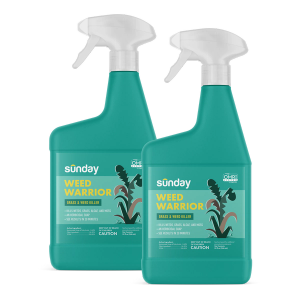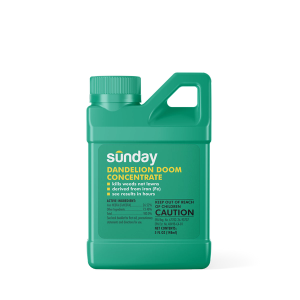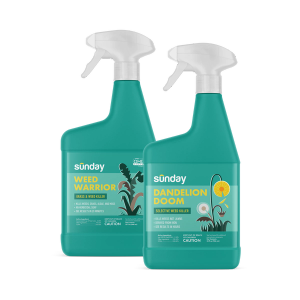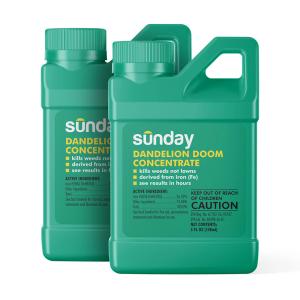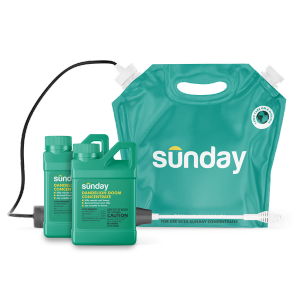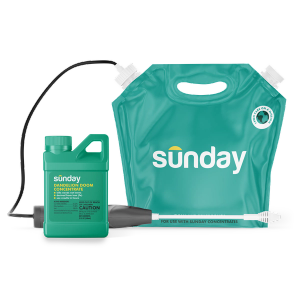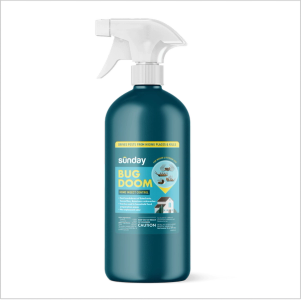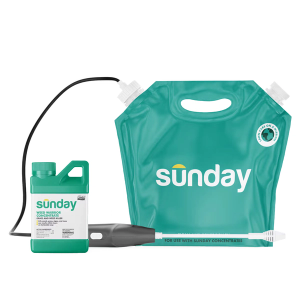If you've spotted bright green, round leaves popping up in your lawn that look like tiny lily pads, you're dealing with dollarweed.
This moisture-loving plant is one of the most common lawn weeds we hear about from homeowners. While Sunday doesn't currently offer a specific herbicide for dollarweed, we can help you understand why it's there and how to manage it naturally.
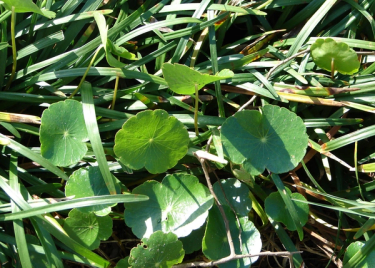
Photo credit: LSU AGCenter
What is dollarweed?
Dollarweed, also called pennywort, gets its name from its distinctive silver-dollar-shaped leaves. These bright green, fleshy leaves are round with scalloped edges and measure about 1-2 inches across. They stick up from the ground like miniature lily pads, making them easy to spot in your lawn.
Sunday Tip:
Wanna hear a lawn joke? It's called dollarweed because we spend so many dollars trying to get rid of it by overfertilizing and overwatering our lawns.
Why am I getting so many dollarweeds?
Dollarweed is nature's way of telling you there's too much moisture in your soil. This weed thrives in wet conditions and actually serves as an indicator plant for excessive water.
You'll typically find dollarweed in:
- Low-lying areas that stay damp
- Soils with hard clay that drains slowly
- Areas around ponds or lakes where water levels change
- Well-drained sandy soils that are overwatered
Sunday Tip:
Research from the University of Florida showed that simply reducing how often you water can significantly cut down dollarweed populations. The weed can even float on water, which explains why it loves those soggy spots in your yard.
How do I get rid of dollarweed?
Successful removal requires a two-part approach: removing existing plants and fixing the conditions that allowed them to grow.
Hand removal method
Dollarweed spreads through underground stems called rhizomes, plus seeds and tubers. When pulling by hand, you must get the entire root system or the weed will quickly grow back.
The best time for hand removal is when the soil is moist but not soggy. This makes it easier to pull up the complete root system.
Sunday Tip:
Dollarweed roots can stretch over 5 feet long, so be patient and thorough.
Fix the moisture problem
This is your long-term solution. Water your lawn only when the grass starts to wilt. Most lawns need about 1 inch of water per week, including rainfall. Deep, infrequent watering is better than frequent shallow watering.
For drainage issues:
- Give your lawn more time to dry out between waterings
- Add soil to level low spots that collect water
- Install drainage systems in problem areas
- In severely compacted soil, you can aerate to improve water movement
Does Sunday have a product to get rid of dollarweed?
Currently, Sunday doesn't offer a specific dollarweed control product. However, our approach focuses on building healthy lawns that naturally resist weed problems.
A thick, healthy lawn is your best defense against any weed, including dollarweed. Dense lawns crowd out weeds and make it harder for them to establish.
So, what herbicide would be good for dollarweed?
Chemical control typically requires a combination of pre-emergent and post-emergent herbicides applied at specific times. However, this approach only works on small, young weeds and becomes less effective as plants mature. Even with harsher herbicides, controlling moisture remains crucial for long-term success.
How can I prevent dollarweeds naturally?
Beyond removal and moisture control, focus on building a lawn that naturally resists weeds:
- Mow high: Keep grass at the tallest recommended height to shade out weeds.
- Fertilize wisely: Avoid over-fertilization with MLSN, or minimal levels of sustainable nutrition. All Sunday custom lawn fertilizer plans abide by this methodology.
- Choose the right grass: Select varieties suited to your climate and soil conditions. Unsure what that grass type is? Use Sunday's Seed Finder.
- Improve your soil: Add organic matter to heavy clay soils to improve drainage and create better growing conditions for grass.
Dollarweed problems typically resolve when the underlying moisture issues are addressed. By improving drainage, adjusting your watering schedule, and maintaining strong grass, you can naturally reduce dollarweed populations over time.
Remember: total weed elimination isn't necessary unless you want to spend every waking moment fighting them. The goal is to control weeds to tolerable levels while maintaining a healthy lawn.
Sunday Tip:
A few beneficial weeds in your lawn actually provide biodiversity and help native pollinators. Focus on the big picture: a healthy, functional lawn that you and your family can enjoy.
Let's get growing
Our lawn engine uses satellite data to map out your lawn size and determine things like average rainfall, common weeds, and pest activity.
Cited sources
My Two Cents About Dollarweed. University of Florida IFAS.
Dollarweed. Clemson Cooperative Extension.
Photo credit: LSU AGCENTER.







